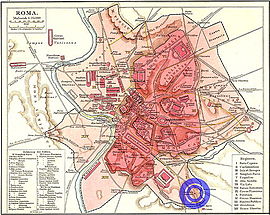
Back Гробница на Сципионите Bulgarian Tomba dels Escipions Catalan Grab der Scipionen German Τάφος των Σκιπιώνων Greek Tumba de los Escipiones Spanish مقبره اسکیپیوس Persian Tombeau des Scipions French Sepolcro degli Scipioni Italian Sepulcrum Scipionum Latin Tombe van de Scipiones Dutch
 Location of the tomb in ancient Rome. | |
 Click on the map for a fullscreen view | |
| Location | Regio IX Circus Flaminius |
|---|---|
| Coordinates | 41°52′34.1″N 12°30′2.7″E / 41.876139°N 12.500750°E |
| Type | Mausoleum |
| History | |
| Builder | Augustus |
| Founded | 28 BC |
The Tomb of the Scipios (Latin: sepulcrum Scipionum),[1] also called the hypogaeum Scipionum, was the common tomb of the patrician Scipio family during the Roman Republic for interments between the early 3rd century BC and the early 1st century AD. Then it was abandoned and within a few hundred years its location was lost.
The tomb was rediscovered twice, the last time in 1780[2] and stands under a hill by the side of the road behind a wall at numbers 9 and 12 Via di Porta San Sebastiano, Rome, where it can be visited by the public for a small admission fee. The location was privately owned on discovery of the tomb but was bought by the city in 1880 at the suggestion of Rodolfo Amedeo Lanciani.[3] A house was subsequently built in a previous vineyard there. The current main entrance to the tomb is an arched opening in the side of the hill, not the original main entrance. After discovery the few surviving remains were moved and interred with honor elsewhere or unknowingly discarded. The moveables—the one whole sarcophagus and the fragments of other sarcophagi—were placed on display in the hall of the Pio-Clementino Museum at the Vatican in 1912. The sepulchre is a rock-cut chambered tomb on the interior, with the remains of a late façade on the exterior.
During the republic the tomb stood in a cemetery for notables and their families located in the angle between the Via Appia and the Via Latina on a connecting road joining the two just past the branch point. It was originally outside the city not far from where the Via Appia passed through the Servian Wall at the Porta Capena. In subsequent centuries new construction changed the landmarks of the vicinity entirely. The wall was expanded to become the Aurelian Wall through which the Porta Appia admitted the Via Appia. The cemetery was now inside the city. The Appian gate today is called the Porta San Sebastiano. Before it is the so-called Arch of Drusus, actually a section of aqueduct. The Via Appia at that location was renamed to the Via di Porta San Sebastiano. It passes through the Parco degli Scipioni where the cemetery once was located. The via is open to traffic. Most of it is lined by walls.